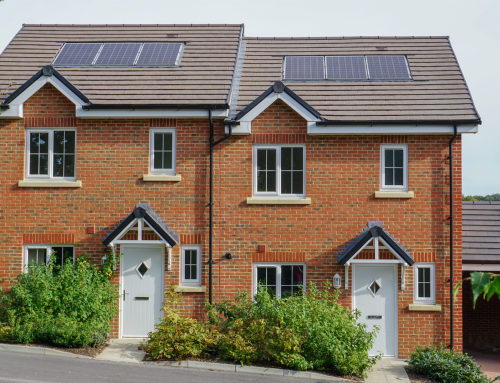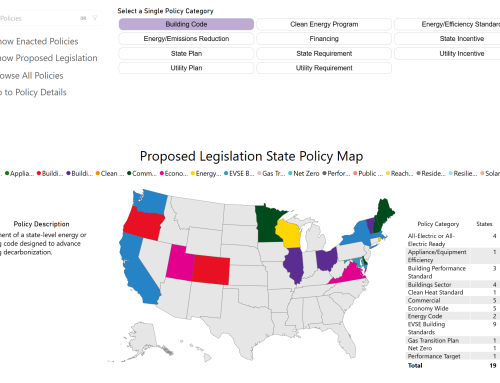
The budget reconciliation bill was passed by the Senate on July 1st, the House by July 3rd, and signed by President Trump on July 4th. As covered in previous digests, billions in building decarbonization and electrification funding was at risk in the process. This week’s digest will provide an update to the threatened tax credits and shine light on programs that survived the reconciliation process.
The IRA Tax Credits
All four buildings-related tax credits embedded in the Inflation Reduction Act (IRA) were under threat throughout the budget reconciliation process. Table 1 describes each of the tax credits in their original form, when passed in the IRA.
Table 1: Building Electrification and Decarbonization Tax Credits
| Tax Credit | Tax Credit Name | Tax Credit Details |
| 25C | Energy Efficient Home Improvement Credit | 30 percent tax credit, up to $3,200, for home improvements made through 2032, including energy efficiency improvements, residential energy property, and home energy audits. |
| 25D | Residential Clean Energy Tax Credit | 30 percent tax credit for households installing renewable energy — battery storage, geothermal heating, rooftop solar, and wind power — from 2022 through 2032. |
| 45L | New Efficient Home Credit | Incentives for homebuilders, for $2,500-5,000 for single family, manufactured, and multifamily homes from 2023 through 2032. |
| 179D | Energy Efficient Commercial Buildings Deduction | Incentives for owners and designers of qualified commercial buildings owned by specified tax-exempt entities from 2023 through 2032. |
Sources: Internal Revenue Service, ENERGY STAR.
All four tax credits had their lifetimes cut down by the budget reconciliation bill. Specifically:
- 25C is amended to end provision of tax credits for home improvements placed in service after December 31st, 2025. The tax credit will still provide a 30 percent credit through the end of the year.
- 25D is amended to end provision of tax credits for homeowners purchasing technologies after December 31st, 2025. The tax credit will still provide a 30 percent credit through the end of the year.
- 45L is amended to end provision of tax credits for new energy-efficient homes purchased after June 30th, 2026.
- 179D is amended to end provision of tax credits for new construction projects that start after June 30th, 2026.
Homeowners and homebuilders should look to expedite their applications and project timelines to take advantage of these credits while they last.
Low Income Energy Assistance Program (LIHEAP)
Nationwide, millions of households have received assistance on their energy bills through LIHEAP, numbering over seven million in 2023. Further, the program was reauthorized last fiscal year for $4.1 billion, in addition to the $500 million injected into it by the Infrastructure Investment and Jobs Act. Despite this volume of funding and assistance that has been provided, in April, the entirety of LIHEAP’s staff was laid off.
A silver lining for the program out of budget reconciliation: LIHEAP funding was not touched by the budget reconciliation bill. Instead, its funding will be decided by the House and Senate Appropriations Committees in the annual appropriations process that will begin later in July.
As of now, all remaining LIHEAP funding for fiscal year 2025 — over $400 million — was released by the Department of Health and Human Services in late April, with states able to draw from their funding beginning in May. Still, President Trump’s proposed fiscal year 2026 set out to eliminate future LIHEAP funding. Yet the program enjoys ongoing, strong bipartisan support. Those interested in preserving the program should contact their members of Congress to voice their support as well.
Weatherization Assistance Program (WAP)
WAP also was not threatened in the budget reconciliation bill. The program’s funding dissemination — including $3.5 billion funded through IIJA — was frozen at the onset of the Trump Administration. Much of that funding flowed from the $3.7 billion released from the program’s fiscal year 2025 allocation in October 2024.
On July 1st, states’ annual formula grants were released by the Department of Energy (DOE), the source of which was the continuing appropriations bill for 2025, which authorized federal funding through September 30th, 2025. Altogether, a total of $355 million was announced.
Less positively, on the same day, DOE released a memorandum removing the inclusion of non-energy impacts in WAP’s energy audits. Specifically, in 2022, the program began allowing the inclusion of these factors into the audit process to better calculate the cost effectiveness of weatherization solutions. Namely, these factors were water usage reductions and the social cost of carbon. As of the release of the memorandum, 15 WAP grantees — states and territories — have integrated the social cost of carbon into their calculations. Given the memorandum, all 15 will have to roll back their audit changes.
As Congress begins its appropriations process, the relevant House and Senate committees will hold the future of LIHEAP and WAP in their hands. If they honor President Trump’s request to zero out the budget for LIHEAP, the millions of households that rely on that funding to afford their energy will not make ends meet. Further, it may force the states to find new sources of money to bridge those gaps. Even if Congress does not eliminate LIHEAP funding, it is unclear what will happen with the program as its staff have all been fired. The future of WAP is even less clear, as President Trump’s budget request did not single it out like it did LIHEAP. It is up to Congress to decide whether to continue this key program to address affordability, home comfort, and energy burden.



